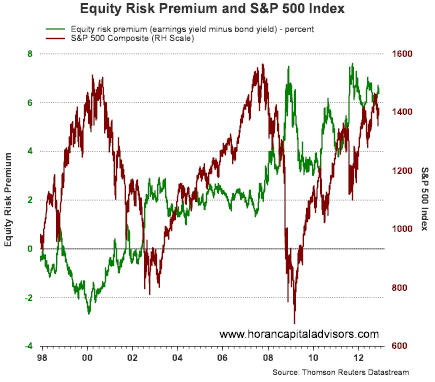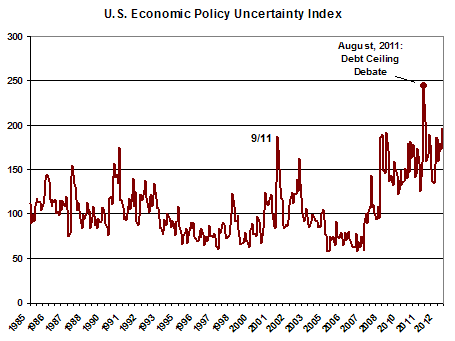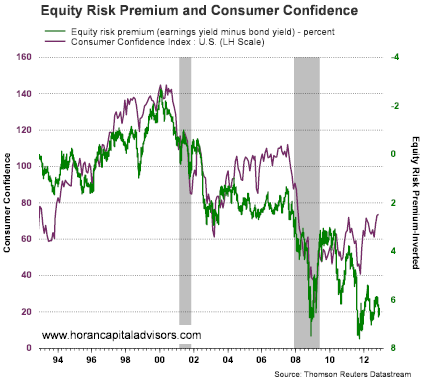Assessing the equity risk premium (ERP) is an important factor for investment professionals and corporate finance officers. I will forgo discussing the importance to a CFO in assessing the ERP and focus on investment professionals. Given the importance of the ERP one will find a surprising amount of disagreement around how to determine the appropriate ERP level. One can perform a "Google search" on "equity risk premium" and find an inordinate amount of research on the topic.
For investors though, determining the appropriate ERP level should play a part in ones asset allocation decision. In short, the equity risk premium quantifies the additional rate of return an investor requires to compensate for the risk of investing in stocks versus a risk free asset, the 10-year treasury bond in this case. If an investor has a view that the market is under valued and likely to go higher, then ones view is the ERP will decline in the future. Conversely, if the investor has a view that the market is over valued and likely to go lower, then the investor believes the ERP will increase in the future. As can be seen with the green line in the below chart, the ERP is trading at near a historically high level. The basis for the calculation of the ERP is the earnings yield for the S&P 500, that is, the inverse of the index's P/E ratio.
As I noted, the ERP calculation used in the above chart is based on the market's earnings yield. Essentially, this is an ex post calculation and what is most important for an investor is the prospective expected market returns or ERP. For readers that are interested in a more detailed discussion of the ERP, Aswath Damodaran, a professor at Stern School of Business at New York University, published a paper (and is frequently updated) on the various methods utilized in calculating the ERP.
Based on the current ERP level, the high excess return expected for the market, an investor should consider allocating a larger percentage of their assets to equities versus the risk free treasury bond asset. However, I have discussed several times about the fact investors continue to seek out bond investments versus equity investments based on fund flow data. The recent fund flow release from ICI continues to note the flow of funds out of equities and into bonds. Given the relatively high ERP, why are investors not allocating more investment dollars to stocks versus bonds?
Although investors my not allocate larger dollars to equities, this doesn't mean stocks won't generate returns in excess of bonds. From a behavioral perspective investors tend to fear losses more than missing out on gains. With the number of negative market shocks investors have experienced since the year 2000, tech bubble, financial market crisis and the real estate bubble, this fear of loss is not surprising. Additionally, the markets hate uncertainty and events in Washington, D.C. have done anything but create more uncertainty.
The below chart of the U.S. Economic Uncertainty Index is at its highest level other than the level reported at the height of the debt ceiling debate in August last year. The on again off again fiscal cliff discussions in Washington also include approval to raise the U.S.'s debt ceiling. The debt ceiling debate in 2011 was not a positive for the equity markets. 
At the end of the day, investors not only need to have a longer term horizon to invest in equities, but they need to have tools to help evaluate the potential direction of the ERP. There are several variables investors can utilize, like the Index of Leading Economic Indicators. This is important as it provides insight into the direction of the economy and hence the impact on corporate earnings. Also, investors can look at the consumer confidence index due to its inverse correlation to the ERP.
An article in the Journal of Investment Consulting, Does the Stock Market's Equity Risk Premium Respond to Consumer Confidence or Is It the Other Way Around?, provides support that so long as consumer confidence does not remain at near historical lows, long term investors can find the current risk/reward of the equity market attractive. The cited research in the article indicates satisfactory equity returns can be achieved with relatively low downside risk.
Which stock should you buy in your very next trade?
With valuations skyrocketing in 2024, many investors are uneasy putting more money into stocks. Unsure where to invest next? Get access to our proven portfolios and discover high-potential opportunities.
In 2024 alone, ProPicks AI identified 2 stocks that surged over 150%, 4 additional stocks that leaped over 30%, and 3 more that climbed over 25%. That's an impressive track record.
With portfolios tailored for Dow stocks, S&P stocks, Tech stocks, and Mid Cap stocks, you can explore various wealth-building strategies.
